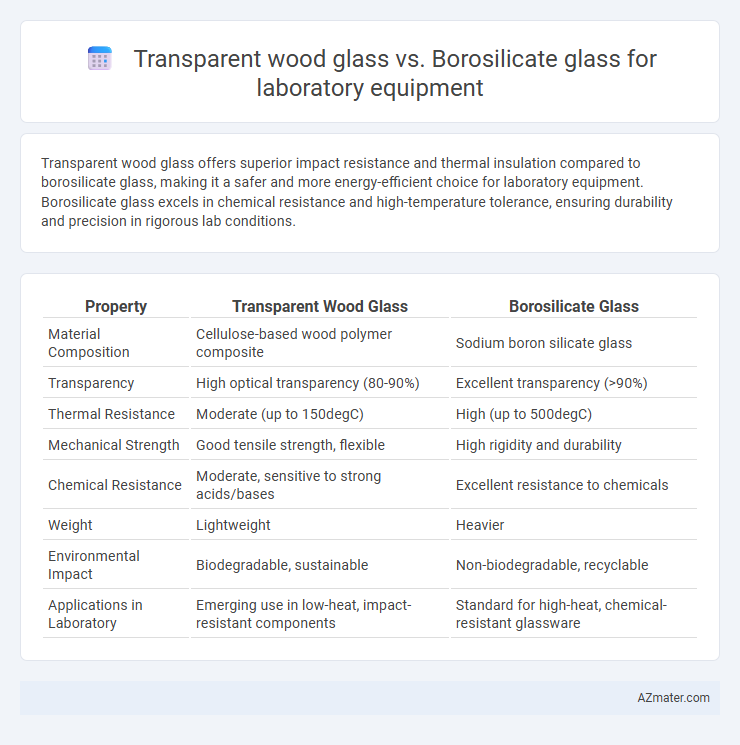Transparent wood glass offers superior impact resistance and thermal insulation compared to borosilicate glass, making it a safer and more energy-efficient choice for laboratory equipment. Borosilicate glass excels in chemical resistance and high-temperature tolerance, ensuring durability and precision in rigorous lab conditions.
Table of Comparison
| Property | Transparent Wood Glass | Borosilicate Glass |
|---|---|---|
| Material Composition | Cellulose-based wood polymer composite | Sodium boron silicate glass |
| Transparency | High optical transparency (80-90%) | Excellent transparency (>90%) |
| Thermal Resistance | Moderate (up to 150degC) | High (up to 500degC) |
| Mechanical Strength | Good tensile strength, flexible | High rigidity and durability |
| Chemical Resistance | Moderate, sensitive to strong acids/bases | Excellent resistance to chemicals |
| Weight | Lightweight | Heavier |
| Environmental Impact | Biodegradable, sustainable | Non-biodegradable, recyclable |
| Applications in Laboratory | Emerging use in low-heat, impact-resistant components | Standard for high-heat, chemical-resistant glassware |
Introduction to Transparent Wood Glass and Borosilicate Glass
Transparent wood glass is an innovative material combining the natural cellulose structure of wood with a polymer matrix, offering high strength, lightweight properties, and excellent optical clarity, making it a sustainable alternative to traditional glass in laboratory settings. Borosilicate glass, widely used in laboratories, is prized for its exceptional thermal resistance, chemical durability, and mechanical strength due to its boron oxide composition, allowing it to withstand rapid temperature changes and aggressive chemicals. Both materials serve critical roles in lab equipment, with transparent wood glass emerging as an eco-friendly option and borosilicate glass maintaining its status as a reliable, high-performance standard.
Material Composition and Structure
Transparent wood glass, composed of cellulose fibers infiltrated with a polymer matrix, offers a lightweight, biodegradable alternative with unique anisotropic properties, whereas borosilicate glass is a hard, durable, and chemically resistant material made primarily of silica and boron trioxide. The cellulose structure in transparent wood glass provides flexibility and enhanced impact resistance, while borosilicate glass's amorphous, non-porous structure ensures high thermal stability and resistance to thermal shock in laboratory settings. Both materials serve different functional advantages in lab equipment, with transparent wood glass emphasizing eco-friendliness and borosilicate glass offering proven chemical and heat resilience.
Mechanical Strength and Durability
Transparent wood glass exhibits high mechanical strength due to its reinforced cellulose structure, making it resistant to impact and bending compared to traditional glass. Borosilicate glass offers exceptional thermal shock resistance and chemical durability, maintaining integrity under extreme temperature fluctuations common in laboratory settings. While transparent wood glass provides enhanced toughness and lightweight advantages, borosilicate glass remains superior for high-temperature applications and chemical exposure in lab environments.
Optical Clarity and Light Transmittance
Transparent wood glass exhibits a unique optical clarity with a light transmittance rate typically around 85-90%, offering a natural diffusion of light that reduces glare and minimizes reflections. Borosilicate glass, renowned for its superior optical clarity, provides a light transmittance of approximately 92-95%, ensuring precise visibility with minimal distortion for laboratory applications. While borosilicate glass excels in high clarity and consistency, transparent wood glass combines adequate transparency with enhanced impact resistance and sustainability.
Thermal Stability and Resistance
Transparent wood glass exhibits moderate thermal stability with resistance typically up to 150degC, making it less suitable for high-temperature laboratory applications. Borosilicate glass offers superior thermal resistance, enduring rapid temperature changes and continuous use up to approximately 500degC without cracking. The enhanced thermal stability and resistance of borosilicate glass ensure reliable performance in most demanding laboratory environments.
Chemical Resistance in Laboratory Environments
Borosilicate glass exhibits superior chemical resistance in laboratory environments, with high durability against acids, bases, and solvents, making it ideal for handling aggressive chemicals without degradation. Transparent wood glass, while offering innovative mechanical properties and sustainability benefits, generally lacks the extensive chemical inertness of borosilicate glass and may be prone to surface damage or chemical interactions under harsh laboratory conditions. The choice between these materials for laboratory equipment hinges on borosilicate glass's proven chemical stability and transparency for precise observations.
Weight and Handling Characteristics
Transparent wood glass offers significantly reduced weight compared to borosilicate glass, making it easier to handle during laboratory procedures. Its enhanced flexibility reduces the risk of breakage, providing improved safety and durability over the brittle nature of borosilicate glass. These weight and handling advantages contribute to increased efficiency and ergonomic comfort in lab environments.
Sustainability and Environmental Impact
Transparent wood glass exhibits superior sustainability compared to borosilicate glass, as it is derived from renewable cellulose materials and features a biodegradable composition that reduces landfill waste. This innovative material also requires less energy-intensive manufacturing processes, leading to a smaller carbon footprint than the traditional high-temperature production of borosilicate glass. In laboratory environments striving for eco-friendly practices, transparent wood glass offers a promising alternative that combines durability with significantly lower environmental impact.
Cost Analysis and Economic Feasibility
Transparent wood glass offers a cost advantage over borosilicate glass due to its lower raw material and manufacturing expenses, making it a more economically feasible option for certain laboratory applications. While borosilicate glass provides superior thermal resistance and chemical durability, its higher production costs and brittleness contribute to increased expenses in handling and replacement. Evaluating the total lifecycle cost, transparent wood glass emerges as a budget-friendly choice when durability and moderate thermal performance suffice, enhancing overall cost-effectiveness in laboratory equipment procurement.
Future Trends in Laboratory Glassware Materials
Transparent wood glass offers promising sustainability benefits through its renewable, biodegradable properties and high mechanical strength, making it a potential alternative to traditional borosilicate glass in lab settings. Borosilicate glass remains the industry standard due to its excellent thermal resistance, chemical inertness, and durability, critical for precise laboratory applications. Future trends suggest increasing research into hybrid materials combining the eco-friendly aspects of transparent wood with the robustness of borosilicate glass to enhance performance and reduce environmental impact in laboratory glassware.

Infographic: Transparent wood glass vs Borosilicate glass for Laboratory equipment
 azmater.com
azmater.com